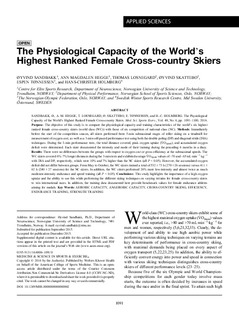| dc.contributor.author | Sandbakk, Øyvind | |
| dc.contributor.author | Hegge, Ann Magdalen | |
| dc.contributor.author | Losnegard, Thomas | |
| dc.contributor.author | Skattebo, Øyvind | |
| dc.contributor.author | Tønnessen, Espen | |
| dc.contributor.author | Holmberg, Hans-Christer | |
| dc.date.accessioned | 2017-02-28T13:03:31Z | |
| dc.date.available | 2017-02-28T13:03:31Z | |
| dc.date.issued | 2016-06 | |
| dc.identifier.citation | Medicine and Science in Sports and Exercise. 2016, 48, 1091-1100 | nb_NO |
| dc.identifier.uri | http://hdl.handle.net/11250/2432365 | |
| dc.description.abstract | Purpose: The objective of this study is to compare the physiological capacity and training characteristics of the world_s six highest ranked female cross-country skiers (world class (WC)) with those of six competitors of national class (NC). Methods: Immediately before the start of the competition season, all skiers performed three 5-min submaximal stages of roller skiing on a treadmill for measurement of oxygen cost, as well as a 3-min self-paced performance test using both the double poling (DP) and diagonal stride (DIA) techniques. During the 3-min performance tests, the total distance covered, peak oxygen uptake (V˙ O2peak), and accumulated oxygen deficit were determined. Each skier documented the intensity and mode of their training during the preceding 6 months in a diary. Results: There were no differences between the groups with respect to oxygen cost or gross efficiency at the submaximal speeds. The WC skiers covered 6%–7% longer distances during the 3-min tests and exhibited averageV˙ O2peak values of ~70 and ~65 mLIminj1Ikgj1 with DIA and DP, respectively, which were 10% and 7% higher than the NC skiers (all P G 0.05). However, the accumulated oxygen
deficit did not differ between groups. From May to October, the WC skiers trained a total of 532 T 73 h (270 T 26 sessions) versus 411 T 62 h (240 T 27 sessions) for the NC skiers. In addition, the WC skiers performed 26% more low-intensity and almost twice as much moderate-intensity endurance and speed training (all P G 0.05). Conclusions: This study highlights the importance of a high oxygen uptake and the ability to use this while performing the different skiing techniques on varying terrains for female cross-country skiers to win international races. In addition, the training data documented here provide benchmark values for female endurance athletes aiming for medals. | nb_NO |
| dc.language.iso | eng | nb_NO |
| dc.publisher | American College of Sports Medicine | nb_NO |
| dc.subject | aerobic capacity | nb_NO |
| dc.subject | anaerobic capacity | nb_NO |
| dc.subject | cross-country skiing | nb_NO |
| dc.subject | efficiency | nb_NO |
| dc.subject | endurance training | nb_NO |
| dc.subject | strength training | nb_NO |
| dc.title | The physiological capacity of the world's highest ranked female cross-country skiers | nb_NO |
| dc.type | Journal article | nb_NO |
| dc.type | Peer reviewed | nb_NO |
| dc.subject.nsi | VDP::Samfunnsvitenskap: 200::Samfunnsvitenskapelige idrettsfag: 330::Andre idrettsfag: 339 | nb_NO |
| dc.source.journal | Medicine and Science in Sports and Exercise | nb_NO |
| dc.identifier.doi | 10.1249/MSS.0000000000000862 | |
| dc.description.localcode | Seksjon for fysisk prestasjonsevne / Department of Physical Performance | nb_NO |
